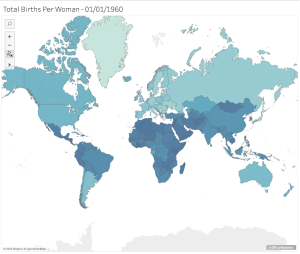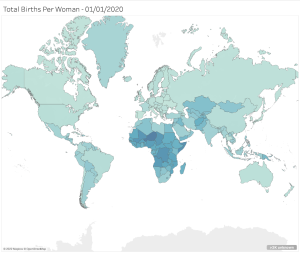
Explaining Decreasing Fertility Rates in Africa
Fertility rates have dramatically decreased all around the world since the 1960s. The most rapid decrease was seen in developed countries, with developing ones following suit, albeit at a slower pace. Of these developing countries, the African Region has displayed a dramatic decline in its fertility rate. In keep with the UN Sustainable Development Goals, this decrease can be attributed to better access to healthcare and reproductive options in Africa across the board, the major pillars of SDG 3: Ensure healthy lives and promote well-being at all ages.


Comparing the two snapshots depicting fertility rates across the world between 1960 and 2020 indicates that globally, the number of births per woman has significantly gone down (noticeable by the change in color from dark blue in 1960 to lighter shades in 2020). Africa is obviously the darkest region compared to the rest of the world in both images, however, fertility rates in African countries have nearly halved between 1960 and 2020, with some countries, such as South Africa, achieving rates as low as those of developed countries.
Potential Reasons for this Decline:
- Better healthcare:
- In line with SDG3.c, health expenditure per capita (current $US) has steadily increased across Africa between 2000 and 2020.
- The number of births attended by skilled professionals has been on the rise, reaching nearly 70% in Eastern and Southern Africa
- Average infant mortality rate has more than halved across the African continent
- The number of children under 5 taken to a health provider has increased, albeit modestly
- Informed decisions regarding reproductive health:
- The percentage of women making informed decisions regarding sexual relations, contraceptive use, and reproductive healthcare has increased, going as high as 73% in countries like Madagascar
- The percentage of women using contraceptives has more than doubled across the different African regions, with nearly 40% of women practicing safe sex in Eastern and Southern Africa in 2019, up from 16.5% in 1990.
Recommendations:
Better access to healthcare enables a safer birthing process and post-natal care. Hence, governments should continue to spend on healthcare to further decrease infant mortality rates, improve maternal care, and increase access to reproductive health options. Increased spending on women’s education should also be promoted, as this will improve their knowledge around their health and bodies, as well as that of their children, and provide them with skills to improve their livelihoods and future.